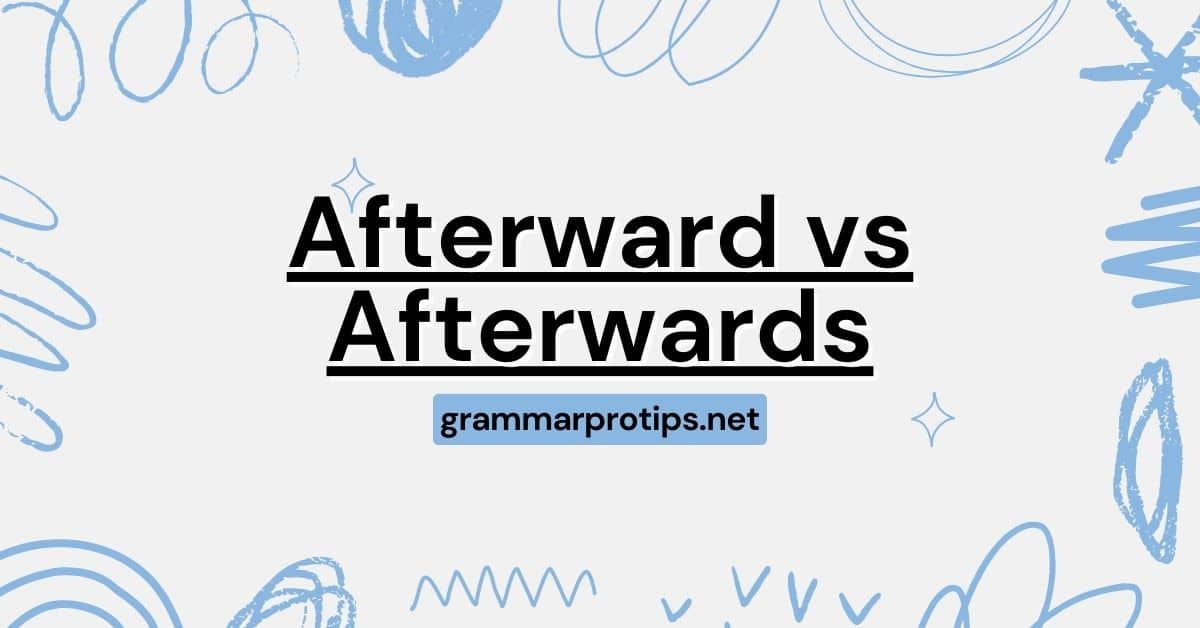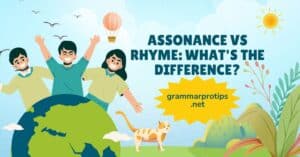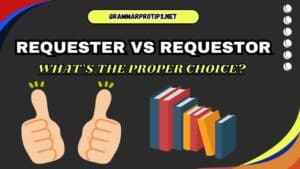Afterward vs Afterwards, When it comes to English, subtle distinctions between similar words can often cause confusion. One such pair is “afterward” and “afterwards.” Both words appear to carry the same meaning, so why do we have two variations? Is there a difference between them? Are they interchangeable?
In this article, we’ll explore the afterward or afterwards debate, delve into their meanings, usage, and the rules governing these terms in different contexts, including grammar, writing style guides, and regional preferences.
By the end, you’ll know exactly when to use “afterward” and when to choose “afterwards.” Plus, we’ll even look at afterward or afterwards synonym to broaden your vocabulary and understanding.
Afterward or Afterwards: Meaning
Before diving into usage and grammar rules, it’s essential to understand what both of these words mean.
Both “afterward” and “afterwards” are adverbs. They generally refer to something that happens later in time or subsequently. In simpler terms, these words are used to show that something occurred following or after another event.
Afterward or Afterwards Meaning:
- Afterward: Refers to something happening later, after a particular event or time.
- Afterwards: This is the same as “afterward,” just a more commonly used variant in British English.
Let’s take a closer look at how these words can be used in sentences.
Is it Afterward or Afterwards?
This is a common question many people ask when writing or speaking. The answer largely depends on where you are.
In American English, “afterward” is preferred, whereas in British English, “afterwards” is more commonly used. However, both are correct and widely accepted in their respective regions.
So, if you’re writing for an American audience, using “afterward” might be the better choice. Conversely, if you’re addressing a British audience, “afterwards” may feel more natural.
Afterward or Afterwards Synonym
If you’re looking for alternatives to these two words, there are several synonyms you can use, depending on the context. Here are a few:
- Later
- Subsequently
- Following
- Eventually
- After
Each of these words can work in various contexts, but keep in mind that “afterward” and “afterwards” typically imply a direct connection to the previous event in time.
How to Use Afterwards
Let’s break down how to use afterwards in various scenarios. While afterward tends to be more concise and popular in the United States, “afterwards” can be used in much the same way.
Example 1: Casual Conversation
After a casual event like a dinner party, you might send a message or email thanking someone. Here’s how “afterwards” could fit into the sentence:
Email Scenario:
Subject: Thanks for the Lovely Dinner!
Dear Sarah,
I just wanted to thank you again for inviting me over last night. I had a wonderful time! Afterwards, I took a walk around the block to help digest all that delicious food.
Looking forward to seeing you again soon!
Best regards,
Anna
In this scenario, “afterwards” shows that the walk took place following the dinner, in a manner that is easy and conversational.
Example 2: Professional Email
In more formal contexts, such as a work-related email, the word “afterwards” can still fit seamlessly.
Email Scenario:
Subject: Follow-up on Today’s Meeting
Dear Mr. Thomas,
I hope this message finds you well. I wanted to thank you for taking the time to meet with me earlier today. Afterwards, I reviewed our conversation and started drafting the report as we discussed.
Please let me know if you would like to make any changes.
Best regards,
Laura Peterson
In this professional setting, “afterwards” indicates that the action of reviewing the conversation happened immediately after the meeting.
Afterward or Afterwards UK and US Usage
As mentioned earlier, there is a notable difference between the UK and US preferences for “afterward” or “afterwards.” Americans generally prefer “afterward,” while Britons lean toward “afterwards.”
Example of Afterward in the US:
After the meeting, I will review the report.
Example of Afterwards in the UK:
After the meeting, I will review the report afterwards.
In fact, when it comes to the AP Style or most style guides, “afterward” is the preferred version in American English, while “afterwards” is acceptable in British English.
Afterward or Afterwards Examples: Real-Life Scenarios
Let’s look at a few more afterward or afterwards examples in real-life scenarios. These will help clarify how and when to use each variation.
Example 1: A Book Review
Afterward or afterwards can appear in a book review or summary of a plot to describe events happening after a key moment in the story.
Example:
The protagonist faced a series of challenges in the first chapter. Afterwards, she discovered new allies who helped her overcome the odds.
Example 2: In a Movie Review
In a movie review, you could use “afterward” or “afterwards” to describe what happens after the initial events.
Example:
The film starts with a tense confrontation. Afterwards, the characters begin their journey, trying to uncover the truth.
Example 3: An Event Description
In an event description or recap, you might write:
Example:
We attended the concert last weekend. Afterward vs Afterwards, we went to a local diner to discuss our favorite songs from the show.
Afterward vs Afterwards: Which One Should You Use?
The short answer is: It depends on where you’re located and who you’re writing for. Here are some guidelines:
- If you’re in the United States: Use “afterward.”
- If you’re in the United Kingdom or writing for a British audience: Use “afterwards.”
- In formal writing: If you’re unsure, check the style guide you’re following, as AP Style tends to favor “afterward.”
While both versions are grammatically correct, consistency in your writing is key. Whether you choose “afterward” or “afterwards,” stick with one version throughout your document or piece of writing.
Toward vs Towards: A Quick Note
While we’re discussing prepositions like “afterward” and “afterwards,” it’s also worth addressing another common question: Is it “toward” or “towards”?
The difference is similar to afterward vs afterwards:
- In American English, “toward” is preferred.
- In British English, “towards” is often used.
However, like afterward or afterwards, both versions are generally understood and accepted.
Table: Afterward vs Afterwards Usage
To wrap up our discussion, here’s a helpful table summarizing the differences and uses of “afterward” and “afterwards” in various contexts:
| Usage Context | Afterward (US) | Afterwards (UK) |
|---|---|---|
| General meaning | Later, after | Later, after |
| Preferred in US | ✅ | ❌ |
| Preferred in UK | ❌ | ✅ |
| AP Style | ✅ | ❌ |
| Informal conversations | ✅ | ✅ |
| Formal writing | ✅ | ✅ |
Conclusion
In conclusion, whether you choose afterward or afterwards, the important thing is understanding their meaning and using them in the right context. While both words have the same basic definition, their use can differ depending on regional preferences and writing style guidelines. By following these simple rules and examples, you’ll be able to use these adverbs confidently and correctly.
Now you’re ready to write with clarity and style afterward or afterwards, the choice is yours!

Sienna Mauldon is a passionate writer and grammar expert. On her blog, she shares easy-to-follow guides to help readers master grammar rules and improve their writing. With a love for language and teaching, Sienna makes grammar simple and fun for everyone, from beginners to experienced writers.








